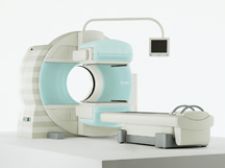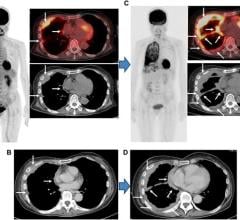
Siemens' Symbia E SPECT is designed to offer high-quality imaging at an affordable price.
Small and large medical imaging equipment suppliers alike are struggling with slowed equipment sales resulting from tighter capital budgets that stem from the Deficit Reduction Act (DRA) of 2005, which took effect January 1, 2007.
To survive the draconian reimbursement cuts in medical imaging, these suppliers must either adapt or die. The trick is to reduce cost without cutting corners on quality, and a few of the leading manufacturers have found the right formula for doing just that.
The DRA legislation targets medical imaging procedures and related products and services primarily because they have been identified as the fastest growing costs in healthcare. Subsequently, medicare reimbursement for imaging already has decreased by more than $13 billion as part of the DRA. The reduced coverage results in a lack of access to much needed medical imaging services, including applications using ultrasound, positron emission tomography (PET), single photon emission computed tomography (SPECT), magnetic resonance imaging (MRI), computed tomography (CT), nuclear imaging and X-rays across multiple indications.
Reimbursement rates until now have been left to each state, with some states, such as New York and California, favoring relatively reasonable rates and others less so. As it stands today, Medicare reimbursement rates for imaging services in physician offices and independent imaging centers was lowered an estimated 18 to 19 percent below total reimbursement for similar services in hospital outpatient departments.
At Radiology Associates of South Florida, where they use two Philips hybrid SPECT/CT 16–slice systems, the impact of the DRA has weighed in. “Any time there is an unknown in reimbursement rates, medical equipment sales are affected. That’s the situation the cardiac medical imaging is currently in. CMS is closely reviewing the practices of physicians ordering these tests to determine whether they are medically necessary,” Jack Ziffer, Ph.D., M.D., chairman of radiology associates of South Florida, chief of Imaging Services , Baptist Hospital of Miami, medical director, cardiac imaging, the Baptist Cardiac and Vascular Institute.
While many manufacturers are toughing it out, some large players have chosen to divest their assets in imaging. Bristol-Meyers Squibb Co., for example, sold its medical imaging business unit for approximately $525 million to Avista, a private equity firm, on January 8, 2008. This came after its medical imaging unit reported fourth quarter net sales had slipped from $142 million in 2007 from $156 million in 2006.
SPECT adapts to the DRA
One imaging system that Siemens has modified to lower the overall price, yet still offer high-image quality, is SPECT. In October 2007, Siemens introduced the new Symbia E Series SPECT Image, at the 2007 European Association of Nuclear Medicine Annual Congress. This new imager, typically hospital based, incorporates a new camera with an improved chassis and electronics that are said to greatly enhance image quality and reliability. These modifications are designed to improve the accuracy of diagnoses. Also, the Symbia E can be upgraded to accommodate a larger workload as clinical practices grow. Symbia E is equipped with remote servicing capabilities, a feature that allows checking the system status through remote access and diagnostics to enable system corrections to reduce downtime and therefore cost. Workflow solutions such as a physician worklist and cardio-Flash reconstruction software and the integrated quality control component are meant to save time as well.
Marcus Lusser, vice president, global sales and marketing, Molecular Imaging Division, Siemens Medical Solutions, says Siemens takes a three-pronged approach to the current cost pressures in the medical imaging market. The small c.cam has been developed for use in physician offices, the Symbia E is primarily for hospital use and hybrid devices such as Biograph and Symbia T for PET/CT and SPECT/CT imaging, respectively, are used for more complex cases. “A primary goal of ours is to offer high-quality cardiac images at a range of prices and help prevent unnecessary and expensive medical interventions. Using molecular imaging techniques in cardiology, we can determine the extent of diseases earlier and prevent the costlier interventions that might not be necessary.”
Cardiac SPECT in half the time
An important strategy allowing hospitals and imaging centers to compensate for reduced imaging reimbursements is increasing patient throughput. That can be achieved by improving efficiencies in the imaging process. According to Kevin Boyle, GE Healthcare product manager, the DRA compounds the already tremendous pressure their customers are feeling, and GE is helping them address the DRA challenge by focusing on clinical and economic relevance in their current and future products.
A prime example of this is Evolution for Cardiac, a cardiac solution that supports CT-based attenuation correction and is designed to cut imaging time in half. Evolution for Cardiac is based on technologies developed at the University of North Carolina at Chapel Hill and Johns Hopkins University, and is used for both gated and non-gated cardiac SPECT and SPECT/CT. The software reportedly improves the positional accuracy of imaging through 3D modeling of the collimator-detector response function. Quality images are obtained in less time with a better patient experience. Because the patient spends less time (about half) on the table being imaged, patients move less, resulting in better images. Also, because the software is integrated into the workstation, the technologist’s workflow is faster and easier. This, in turn, increases patient throughput.
Hybrid solution
Another approach to addressing the uncertainties of the economic climate is to focus resources on hybrid cardiac tests. For more complex patient cases, the capabilities of either dedicated SPECT or diagnostic CT or for hybrid imaging, the Precedence 64-slice SPECT/CT by Philips offers several innovations. Using CT with SPECT can help identify early disease and clarify ambiguous results of other tests. Precedence combines CT-based attenuation correction, calcium scoring and CTA in one system. The scanner produces myocardial perfusion imaging in, according to Philips, half the time of conventional scanners, allowing faster patient throughput. The new IT upgrade, Philips Xcelera R2.2 integrates exam results from key cardiology subspecialties so that relevant images, such as nuclear cardiology, cardiac CT, cardiac MRI and electrophysiology and electrocardiograms, and information is available in a centralized location, again, saving time. Precedence includes new or enhanced reporting tools for 2D and 3D Echo, 2D and 3D cardiac CT and MR and electrophysiology recording and mapping information as well.
Even with the DRA, however, there is a silver lining. By offering unique targeted responses to a shaky medical imaging market, manufacturers are driving improved clinical operations and better patient outcomes at lower costs.


 November 18, 2025
November 18, 2025 









